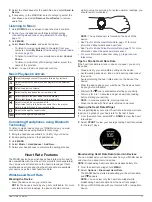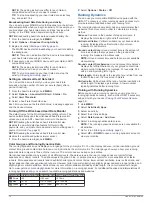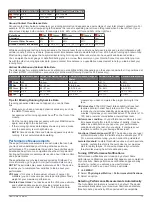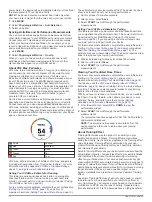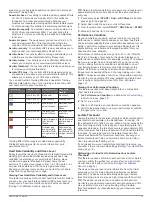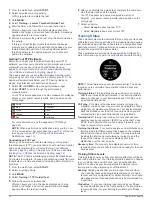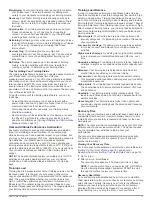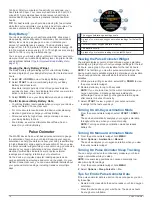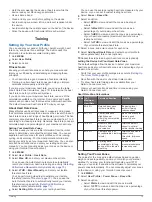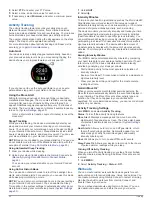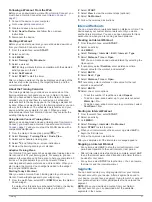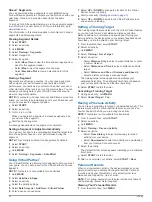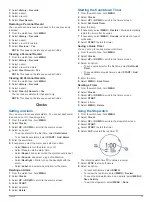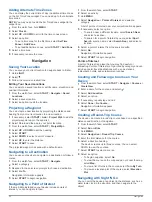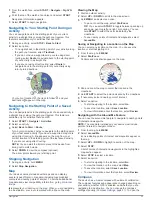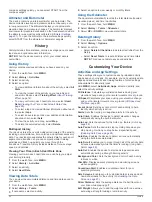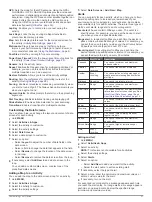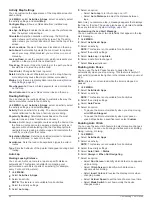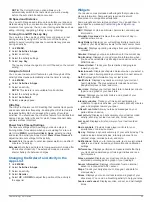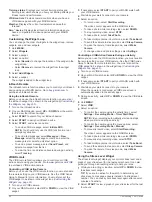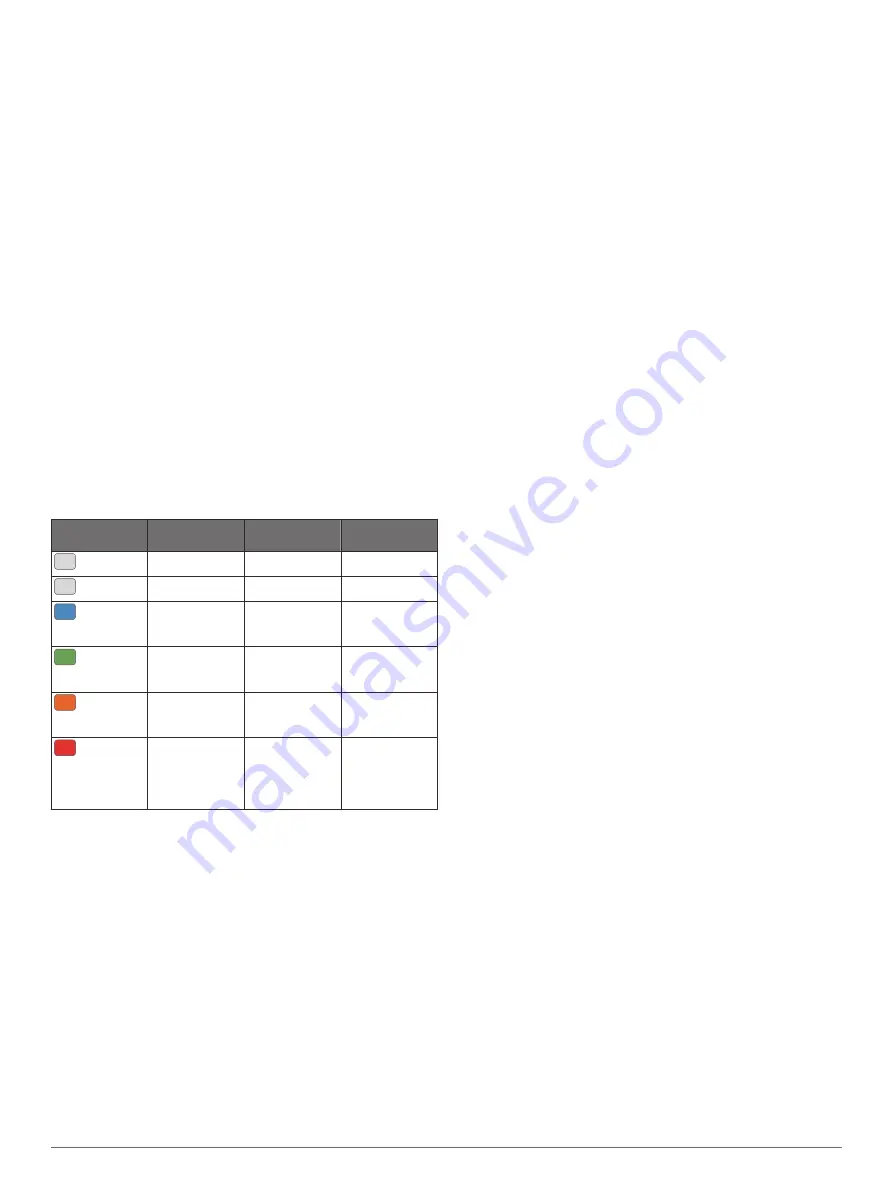
impact on your anaerobic capability and result in an improved
anaerobic Training Effect.
Anaerobic base
: Your ability to maintain easily repeated efforts
of 10 to 120 seconds at a medium effort. This builds the
foundation for harder anaerobic training because your
muscles are repeatedly working with moderate lactate levels.
Your focus during this activity is to maintain good technique.
Anaerobic capacity
: The average power you can sustain in a
30 to 120 second maximum effort. Your goal during this
activity is to improve your ability to produce and metabolize
lactic acid.
Anaerobic power
: The peak power you can reach in a 5 to 15
second maximum effort. This type of workout tests the
condition of the neuromuscular and intramuscular systems.
Aerobic recovery
: Your activity effort is easy and allows you to
slightly boost your cardiorespiratory fitness level.
Aerobic base
: Your activity effort is average and allows you to
maintain your current cardiorespiratory fitness level.
Aerobic tempo
: Your activity pace is comfortably difficult and
allows you to improve your cardiorespiratory fitness level.
Aerobic threshold
: Your activity effort is intense and allows you
to improve your lactate threshold.
Aerobic VO2 max.
: Your activity effort is demanding and you
are spending time above your current lactate threshold. This
allows you to improve your VO2 max. estimate.
You can add Aerobic Training Effect and Anaerobic Training
Effect as data fields to one of your training screens to monitor
your numbers throughout the activity.
Color Zone
Training Effect Aerobic Benefit Anaerobic
Benefit
From 0.0 to 0.9
No benefit.
No benefit.
From 1.0 to 1.9
Minor benefit.
Minor benefit.
From 2.0 to 2.9
Maintains your
aerobic fitness.
Maintains your
anaerobic
fitness.
From 3.0 to 3.9
Improves your
aerobic fitness.
Improves your
anaerobic
fitness.
From 4.0 to 4.9
Highly improves
your aerobic
fitness.
Highly improves
your anaerobic
fitness.
5.0
Overreaching
and potentially
harmful without
enough recovery
time.
Overreaching
and potentially
harmful without
enough recovery
time.
Training Effect technology is provided and supported by
Firstbeat Technologies Ltd. For more information, go to
.
Heart Rate Variability and Stress Level
Stress level is the result of a three-minute test performed while
standing still, where the MARQ device analyzes heart rate
variability to determine your overall stress. Training, sleep,
nutrition, and general life stress all impact how a runner
performs. The stress level range is from 1 to 100, where 1 is a
very low stress state and 100 is a very high stress state.
Knowing your stress level can help you decide if your body is
ready for a tough training run or yoga.
Viewing Your Heart Rate Variability and Stress Level
This feature requires a Garmin chest heart rate monitor. Before
you can view your heart rate variability (HRV) stress level, you
must put on a heart rate monitor and pair it with your device
(
).
TIP:
Garmin recommends that you measure your stress level at
approximately the same time and under the same conditions
every day.
1
If necessary, select
START
>
Add
>
HRV Stress
to add the
stress app to the apps list.
2
Select
Yes
to add the app to your list of favorites.
3
From the watch face, select
START
>
HRV Stress
>
START
.
4
Stand still, and rest for 3 minutes.
Performance Condition
As you complete your activity, such as running or cycling, the
performance condition feature analyzes your pace, heart rate,
and heart rate variability to make a real-time assessment of your
ability to perform compared to your average fitness level. It is
approximately your real-time percentage deviation from your
baseline VO2 max. estimate.
Performance condition values range from -20 to +20. After the
first 6 to 20 minutes of your activity, the device displays your
performance condition score. For example, a score of +5 means
that you are rested, fresh, and capable of a good run or ride.
You can add performance condition as a data field to one of
your training screens to monitor your ability throughout the
activity. Performance condition can also be an indicator of
fatigue level, especially at the end of a long training run or ride.
NOTE:
The device requires a few runs or rides with a heart rate
monitor to get an accurate VO2 max. estimate and learn about
your running or riding ability (
).
Viewing Your Performance Condition
This feature requires wrist-based heart rate or a compatible
chest heart rate monitor.
1
Add
Performance Condition
to a data screen (
).
2
Go for a run or ride.
After 6 to 20 minutes, your performance condition appears.
3
Scroll to the data screen to view your performance condition
throughout the run or ride.
Lactate Threshold
Lactate threshold is the exercise intensity at which lactate (lactic
acid) starts to accumulate in the bloodstream. In running, it is
the estimated level of effort or pace. When a runner exceeds the
threshold, fatigue starts to increase at an accelerating rate. For
experienced runners, the threshold occurs at approximately 90%
of their maximum heart rate and between 10k and half-marathon
race pace. For average runners, the lactate threshold often
occurs well below 90% of maximum heart rate. Knowing your
lactate threshold can help you determine how hard to train or
when to push yourself during a race.
If you already know your lactate threshold heart rate value, you
can enter it in your user profile settings (
).
Performing a Guided Test to Determine Your Lactate
Threshold
This feature requires a Garmin chest heart rate monitor. Before
you can perform the guided test, you must put on a heart rate
monitor and pair it with your device (
).
The device uses your user profile information from the initial
setup and your VO2 max. estimate to estimate your lactate
threshold. The device will automatically detect your lactate
threshold during runs at a steady, high intensity with heart rate.
TIP:
The device requires a few runs with a chest heart rate
monitor to get an accurate maximum heart rate value and VO2
max. estimate. If you are having trouble getting a lactate
threshold estimate, try manually lowering your maximum heart
rate value.
Heart Rate Features
15
Summary of Contents for MARQ DRIVER
Page 1: ...MARQ DRIVER Owner sManual ...
Page 6: ......
Page 51: ......
Page 52: ...support garmin com March 2019 190 02359 00_0A ...











